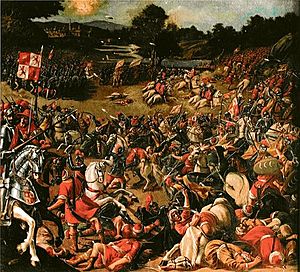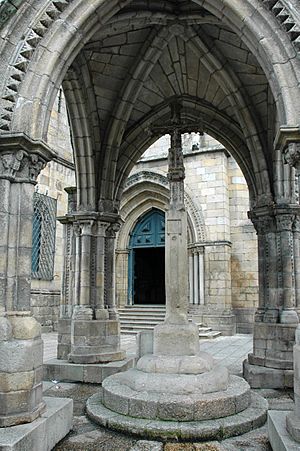Battle of Río Salado facts for kids
Quick facts for kids Battle of Río Salado |
|||||||
|---|---|---|---|---|---|---|---|
| Part of the Reconquista | |||||||
 Canvas of the battle by unknown 17th century author |
|||||||
|
|||||||
| Belligerents | |||||||
| Commanders and leaders | |||||||
Garci Lasso de la Vega II |
|||||||
| Strength | |||||||
|
22,000 1,000 in Tarifa garrison |
67,000 |
||||||
The Battle of Río Salado, also called the Battle of Tarifa, happened on October 30, 1340. It was a major fight between the armies of King Afonso IV of Portugal and King Alfonso XI of Castile. They fought against Sultan Abu al-Hasan 'Ali from the Marinid dynasty and Yusuf I from the Granada. This battle was a big part of the Reconquista, which was a long period when Christian kingdoms took back land in the Iberian Peninsula from Muslim rule.
Contents
Why the Battle Happened
After King Alfonso XI of Castile won a battle in 1330, the ruler of Granada, Muhammed IV, asked for help. He needed support to keep his kingdom safe. The Marinid rulers in North Africa decided to get involved in Spain. Sultan Abu al-Hasan 'Ali wanted to expand his territory.
In 1333, the Marinids sent a large fleet and 5,000 soldiers to Spain. They helped the King of Granada capture Gibraltar from Castile. After this, Abu Hasan gathered an even bigger army. He planned to invade Castile and undo the Christian gains from the past 100 years. This invasion was the Marinids' last big attempt to create a strong base in Spain.
Getting Ready for Battle
In the winter of 1340, Sultan Abu Hasan prepared his navy. He had 60 warships and 250 other ships. They gathered at Ceuta, a city in North Africa. His army landed at Gibraltar. On April 8, 1340, the Muslim fleet attacked the Castilian fleet in the Strait of Gibraltar. The Castilian fleet was badly defeated, and their admiral, Alfonso Jofre de Tenorio, died.
Abu Hasan and his army crossed the Strait of Gibraltar on August 14, 1340. For the rest of the summer, troops and supplies were brought to Spain. On September 22, they started to surround the city of Tarifa. Yusuf I of Granada helped with this siege. However, Abu Hasan made a big mistake. He thought it would take a long time for the Castilians to rebuild their navy. So, he sent most of his ships away to save money. He left only 12 ships at Algeciras.
Meanwhile, King Alfonso XI of Castile asked for help. He got support from the King of Aragon and his father-in-law, King Afonso IV of Portugal. The Portuguese king sent his navy, led by Admiral Manuel Pessanha. He also hired 15 ships from Genoa, led by Micer Gil Bocanegra. With 27 new ships built quickly in Seville, the Christian fleets became very strong. They appeared in the Strait of Gibraltar in October. This cut off the supply routes between Morocco and Spain for Abu Hasan's army.
Abu Hasan's army was now in a tough spot. They needed supplies from Morocco, but the Christian ships blocked them. On October 10, a big storm damaged 12 Castilian ships. On the same day, the Sultan launched a huge attack on Tarifa. The city barely held on, and both sides suffered heavy losses.
King Alfonso XI left Seville on October 15, 1340, with his army. He met the King of Portugal the next day. They waited for more soldiers to join them. Finally, on October 26, their combined army, now 20,000 strong, marched into enemy territory. When Abu Hasan heard they were coming, he stopped the siege of Tarifa. His army moved to a hill between Tarifa and the sea. Yusuf I placed his army on a nearby hill. On October 29, the Christian army reached Deer Hill, about 8 kilometers from Tarifa. They were only 250 meters from the beach. A valley with two streams, La Jara and El Salado, separated them from the enemy. Since supplies were running low, Alfonso XI decided to attack the next day.
During the night, Alfonso XI sent 1,000 horsemen and 4,000 foot soldiers to Tarifa. He hoped they could surprise the enemy from behind during the battle. They met little resistance and reached Tarifa easily. However, the Muslim officer guarding the area wrongly told Abu Hasan that no Christian soldiers had entered Tarifa. This mistake had serious consequences for the Sultan the next day.
Who Fought?
Historians have different ideas about how many soldiers fought in this battle. Some old Spanish writings said Abu Hasan had 40,000 knights and 400,000 foot soldiers. These numbers are likely much too high. A more realistic estimate suggests the Marinids had up to 60,000 men. Granada had about 7,000 knights.
The Christian side had a total of about 22,000 soldiers.
- The Castilians had 8,000 knights and 12,000 foot soldiers.
- The Portuguese brought 1,000 knights.
- The city of Tarifa had a garrison of 1,000 men who joined the battle.
King Alfonso sent 3,000 Castilian knights to help the 1,000 Portuguese knights. They were tasked with attacking Yusuf's 7,000 Granadan knights on the left side of the battlefield. The Castilian foot soldiers were in the middle. Soldiers from Asturias and the Basque areas were armed with lances, crossbows, helmets, and shields. They were positioned next to Afonso IV's knights.
The Battle Begins!
The Christian leaders decided that the Castilian King would attack the Sultan's main army. The Portuguese army, with 3,000 Castilian soldiers helping them, would fight Yusuf I. At nine o'clock on the morning of October 30, 1340, the armies moved out. They left 2,000 new soldiers to guard their camp. The strong Castilian front line was led by the Lara brothers. King Alfonso himself rode in the main part of the army. On the left were archers and crossbowmen from León. On the right was Alvar Pérez de Guzmán with his cavalry. The Portuguese forces were strengthened by knights from the Military Orders of Alcántara and Calatrava.
Abu Hasan had left the Jara stream crossing unguarded. But he had strong forces along the Salado River. The Castilian front line faced tough resistance. The Lara brothers struggled to cross the shallow river. However, the King's sons, Fernando and Fadrique, led 800 knights to the right. They captured a small bridge, pushing back 2,500 enemy cavalry. Alfonso sent 1,500 more knights to help them, and the Salado River was successfully crossed.
In the center, Juan Núñez de Lara and the Military Order of Santiago, with 3,000 knights, finally broke through the enemy line. They also crossed the river and rode quickly up the hill where Abu Hasan's camp was. At the same time, the soldiers hidden in Tarifa attacked the Sultan's camp from behind. The troops defending the camp (about 3,000 horsemen and 8,000 foot soldiers) retreated. Half of them ran towards Algeciras, and the other half joined the main fight in the valley. The Sultan's main army was still mostly intact there.
King Alfonso found himself in a dangerous position. His right wing was far away, and his front line was attacking the enemy camp. Abu Hasan ordered a full attack. The Castilian King was about to fight hand-to-hand when the Archbishop of Toledo, Gil Álvarez Carrillo de Albornoz, stopped him. The timely arrival of the Castilian rearguard (soldiers at the back) helped balance the fight. When the soldiers who had been taking things from the Sultan's camp came down the hill and attacked the enemy from behind, Abu Hasan's surrounded army broke apart. They fled towards Algeciras.
Meanwhile, the Portuguese army had crossed the Salado. When Pedro Nuñez reinforced them, the entire Granadan army broke and left the battlefield. The battle lasted only three hours, from 9 a.m. until noon.
The Christian forces chased the fleeing enemy relentlessly. Many of the Sultan's important family members were captured, including his sister Umalfat, his son Abu Umar Tasufin, and his nephew Alí. Many important leaders were killed during the battle or the chase. Both Abu Hasan and Yusuf managed to reach Algeciras. The Sultan then went to Gibraltar and crossed to Ceuta that same night.
What Happened After?
The Marinids suffered a huge defeat and went back to Africa. A Muslim army never again managed to invade the Iberian Peninsula. The Christians, especially the Castilians and Genoese, now controlled the Straits of Gibraltar.
The war with Granada continued for ten more years. During this time, Alfonso XI gained some small areas in western Granada. Most importantly, the city of Algeciras, which was a valuable stronghold for the Marinids, was finally taken back. This happened after a two-year siege that ended in 1344. Many volunteers from all over Europe came to help with this siege because it was so well-known.
An attempt to take back Gibraltar from the King of Granada failed. However, Castile managed to cut off Gibraltar from the rest of Muslim territory. Peace was agreed in 1350, after King Alfonso XI died in his camp during the Great Plague. Gibraltar was not captured by Castile until 1462.
See also
 In Spanish: Batalla del Salado para niños
In Spanish: Batalla del Salado para niños


